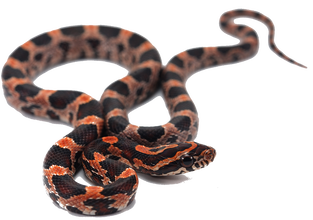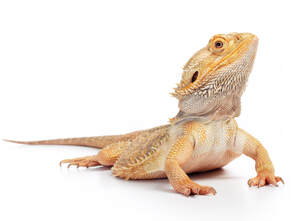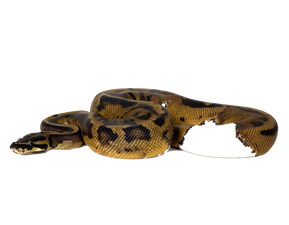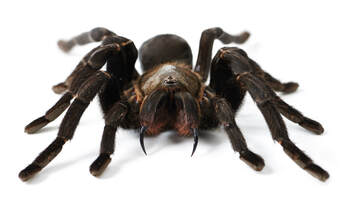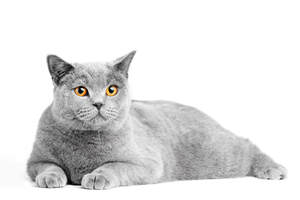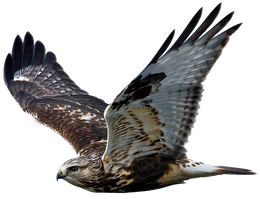Most Popular
Unusual
Tarantulas |
Felines |
Birds of Prey |
Snakes
Lizards
The Basics
What does your breeder or store currently feed the snake?
Are you new to the hobby and aren't sure what's required to take good care of your reptile? One of the questions you need to ask your breeder or the person you're buying the reptile from is what they're currently feeding it?
Depending on what they're already being fed you may need to adjust accordingly as some reptiles, especially snakes can become very finicky with what they eat if they become accustomed to having certain prey as a part of their diet. Some breeders who feed their snakes frozen guinea pigs can have a hard time switching them back to frozen mice or rats because of the very appetizing high fat content that guinea pigs naturally have and rats and mice lack. Snakes get accustomed to certain smells that prey give off. These smells can sometimes be mimicked on new prey items in order to help switch the animal over.
If your snake is one of the larger species like ball pythons or boas that will eventually graduate to eating rats or even rabbits, make sure to try switching them on to small weanling rats while their still juveniles in order to get them adjusted to a new prey item before they grow to large.
Depending on what they're already being fed you may need to adjust accordingly as some reptiles, especially snakes can become very finicky with what they eat if they become accustomed to having certain prey as a part of their diet. Some breeders who feed their snakes frozen guinea pigs can have a hard time switching them back to frozen mice or rats because of the very appetizing high fat content that guinea pigs naturally have and rats and mice lack. Snakes get accustomed to certain smells that prey give off. These smells can sometimes be mimicked on new prey items in order to help switch the animal over.
If your snake is one of the larger species like ball pythons or boas that will eventually graduate to eating rats or even rabbits, make sure to try switching them on to small weanling rats while their still juveniles in order to get them adjusted to a new prey item before they grow to large.
How to switch from live to frozen feeders? (only feed at night)
Make sure the temperature that your snake is used to in its enclosure is at the high end of the hot spectrum that is acceptable for that specific species. Hot snakes tend to be less fussy with their prey items. Make sure you thoroughly thaw your frozen feeder, use water that's warm enough for you to comfortably leave your hand in. Take a pair of tongs with rubber tips so you can avoid the snake hurting itself on something sharp. Pickup the thawed frozen feeder with tongs and hold it about 2 feet away from the enclosure, take a blow dryer and blast the head of the feeder with it and aim it towards the inside of the enclosure so that the smell travels to your snake. Remove lid of the enclosure and dangle the feeder in front of the snake shaking it slightly to help convince the snake the prey item is alive. After it grabs the feeder don't let go of it and pull back a little with the tongs to ensure the snake fully encompasses it. If the snake doesn't immediately take the feeder, stop with feeding and attempt again a few days later with same method.
- DON'T RE-FREEZE FEEDERS THAT HAVE ALREADY BEEN THAWED AS THIS CREATES HARMFUL BACTERIA.
- DON'T RE-FREEZE FEEDERS THAT HAVE ALREADY BEEN THAWED AS THIS CREATES HARMFUL BACTERIA.
Typical Whole Prey Items
|
Rabbits
Guinea Pigs Hamsters Gerbils Eggs Live or Frozen? |
Great Snakes For Beginners!
Feeder Sizing Guides For Snakes
The Munson Feeding Plan (corn snakes)
"please use the chart below as a ROUGH guideline"
Snake Weight (grams) |
Feeder Size (grams) |
Feeder Quantity (1) |
Feeding Frequency (days) |
Feeder Name |
4 - 15g |
0.5 - 3g |
1 |
4 - 5 (days) |
|
16 - 23g |
3 - 4g |
2 |
5 - 6 (days) |
|
24 - 30g |
3 - 6g |
1 |
6 - 7 (days) |
|
30 - 50g |
7 - 9g |
1 |
6 - 7 (days) |
|
51 - 90g |
7 - 12g |
1 |
7 (days) |
|
91 - 170g |
13 - 18g |
1 |
7 (days) |
|
170 - 399g |
19 - 25g |
1 |
7 - 9 (days) |
|
400g + |
30g + |
1 |
10 (days) |
Special Note:
The Munson feeding plan can be a bit aggressive. It's designed to get Corn Snakes up to breeding size as quickly as possible. To be on the safe side you should let your snake reach at least the maximum weight in each category before switching to a new feeder size. This will help prevent regurgitation which can cause harmful sores on the inside of the animal and potentially lead to other more severe health problems .
Ball Pythons - Rule Of Thumb
Generally Ball Pythons can eat 10 - 15% of their own body weight but keep in mind that the larger the difference in size of the feeder to snake ratio, the greater the stress that is put on the snakes body and the higher chance of a mishap or problem occurring during feeding. One such issue can be regurgitation which can cause sores on the inside of a snake from all the acid that builds up during the regurgitating process. Feeders should be no larger than 1.0x - 1.5x the thickest part of a pythons body. Best to stay under the 1.5x marker as it can be overkill.
Feeding Live Vs Feeding Frozen
This goes for all reptiles and not just snakes, feeding live rodents to captive bred reptiles who haven't gained the same instincts that they normally would in the wild is a recipe for disaster. Rodents can be very aggressive when cornered and can easily injure and some times fatally harm a large snake or monitor in captivity. Live rodents can also carry disease that frozen rodents wouldn't normally have since the temperature helps to pause or prevent growth of any pathogens and harmful diseases. Make sure to thaw out your frozen rodents in a bucket of luke - warm water for 15 minutes and not in the microwave unless you want a mess.
How To Thaw Frozen Feeders
DO NOT use a microwave to thaw out your frozen rodents as it can cause harmful bacteria to start growing inside them which can be detrimental to your snakes health! Cooking your rodent in the microwave can also take away from the nutritional value of the rodent itself.
Step 1
Find a ziplock bag.
Step 2
Place feeder inside bag and seal it shut.
Step 3
Place bag in a bucket of warm water, make sure it's NOT boiling hot.
Step 4
Leave bag in bucket for about 10 - 15 minutes or until the rodent feels squishy.
step 5
Make sure the rodent isn't cold to the touch as digesting cold feeders can be very harmful to your cold blooded reptile that can't regulate its own body temperature like we can.
Step 6
Grab a pair of tongs and swing the meal back in forth in front of the snake to get its attention, don't use your hands to feed it as you can get bitten very easily when the snake can't distinguish between your hand and the feeder.
Step 1
Find a ziplock bag.
Step 2
Place feeder inside bag and seal it shut.
Step 3
Place bag in a bucket of warm water, make sure it's NOT boiling hot.
Step 4
Leave bag in bucket for about 10 - 15 minutes or until the rodent feels squishy.
step 5
Make sure the rodent isn't cold to the touch as digesting cold feeders can be very harmful to your cold blooded reptile that can't regulate its own body temperature like we can.
Step 6
Grab a pair of tongs and swing the meal back in forth in front of the snake to get its attention, don't use your hands to feed it as you can get bitten very easily when the snake can't distinguish between your hand and the feeder.
